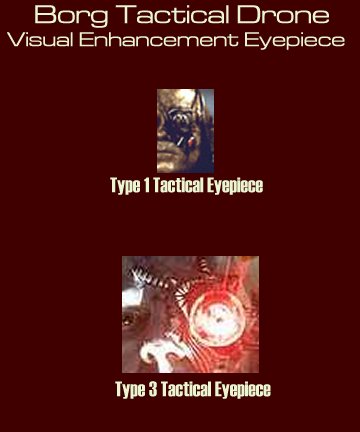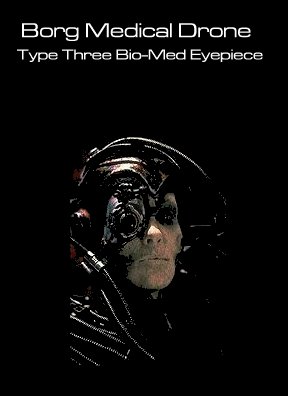Components of Borg Implanted Cybernetic Eyepieces in Captured Borg
Technological Samples.
Philip M. Mancie, Jr. MD Alien
Biotechnology Specialist Star Fleet Life Sciences Division, Section 4, Outpost
070

Parker and Mubrax identified several
class of Borg Drone in their landmark study of 2367 (Identification and
classification of multiple classes of Borg Drones as evidenced in Drone corpses
and body parts retrieved from the first Borg incursion of sector 001 in 2365).
We received several well preserved examples of Borg eyepiece at the 070 facility
in early 2367, just a few months before the publication of Parker and Mubrax's
paper. Our investigative work supports the conclusions of Parker et al,
that the Borg Drones are cybernetically enhanced with their specific classes
role in mind.
From the various eyepieces we examined
immediately after receipt from Star Fleet's facilities we were able to clearly
discern those that afforded the particular hive member special enhanced
abilities to best perform it's specialized tasks. Of the sensory devices
we could definitively identify we were able to surmise which multi-modal visual
units were for tactical, biomedical and technical/support Drones. To date,
several devices related to the eyepieces remain unidentified in terms of
function and/or the underlying Borg technology.
COMMON ELEMENTS IN BORG EYEPIECES
In all of the intact units we studied,
the most obvious common design element is the Borg EVISA-Enhanced Visual
Spectral Amplifier, This small device, under 2 grams in weight is
composed of microcircuitry similar to that found in the non-isolinear
nanocircuits currently under development in both Federation and Klingon
laboratories.
Although the exact design of the sensor
head did vary in some cases, in functionality each system's EVISA worked
identically. The subprocessor interlink was exactly the same in each system,
designed with a terminus at the system split between a neural splice in the
humanoid optic nerve. Further, an additional subprocessor located at the
base of the skull cavity provided a performance enhancement enhancement
algorithm and is interlinked between both the optic nerve and the triple
redundant neural processor in the visual neocortex of the assimilated host.
In testing both intact eyepiece systems
within organic remains and on the bench, in various reverse engineering
schemata, the enhanced visual range detected by our analysis of the EVISA was
very impressive by typical humanoid standards. Greatly increased visual
acuity, up to 800% higher than the highest tested humanoid eyesight, includes
micro/macro and telescopic functionality with automated focus. All of this
is actuated by a single command from the Drone's collective. This is the
equivalent of 3.3 megapixels per 0.01 square millimeter. This is nearly
one third of the resolution of Star Fleet's best current astronomical and
orbital geographic visual sensors in current use.
The neocortical subprocessor provides an
even further degree of visual enhancement, although to what degree or to what
end we remain unsure. A recently noted loop transceiver integrated into
the implant's design indicates that at least some degree of data is transferable
both to and from the collective. The possibility that even view screen
like functions might be channeled through this system has been discussed.
Interestingly some slight variations in
the control code matrix suggests the ability to fine tune the EVISA to the
particular visual physiology of the varied humanoid species the Borg have, and
continue to assimilate. This is not surprising, considering the level of
biotechnology we have seen from the Borg to date.
There is also another small device that
seems to be a sensor for sub-spectral matter & energy analysis (SSA),
utilizing a micro matrix of Lepton enhanced phosphor micro CCD that works in
conjunction with the EVISA's photonic analog to digital semi-organic based
isolinear hybrid converter. Additional neural circuits are forged directly
between the SSA, the EVISA and the nerve plexus of the Drone's visual neocortex.
TACTICAL BORG
DRONE EYEPIECES
The eyepiece of the Parker
designated Tactical Drone presented some intriguing technologies with extremely
advanced defensive and offensive support capabilities.
A Tritium Doxysilicate
Hexatronic processor provides enhanced sensory data on moving objects, allowing
the micro-sub-processor interpretation of multiple targets-obviously
extrapolating a variety of tactical way points for the Drone to consider in
planning it's individualized response to the threat scenario. This is
probably also transmitted in high speed data packets to the collective.
This should also afford the
drone spectacular threat identification and targeting assessment abilities-
although this function is only activated once the collective has identified a
pertinent local threat. This occurs simultaneously with the
initialization of various other individual Borg Drone defensive and offensive
systems, including multi-phasic shielding.
There is also a secondary
function to the Hexatronic device, and that is the ability to discern residual
tachyon signatures. This could provide the drone with the ability to
sense various sub-space and space/time phenomena. Perhaps each Tactical
Drone also acts as an advanced sensory platform for the collective and/or the
command paradigm that is managing the mission or current tasks for that drone.
In either case, some entity utilizes the data and makes tactical decisions based
upon it.
A bi-polar charged Muon
sensor gives the drone the ability detect and possibly in some way visualize
life signs and other biological data at moderate distances under 12 kilometers.
This is not unlike the technologies currently being used as a standard by
a variety of Alpha Quadrant warp capable civilizations, including the
Federation.
A number of data processing
and storage chips are built into the tactical eyepiece. Not unlike
miniature versions of the PMCS chips in a standard Federation tricorder, these
Borg chips have been lab rated at just under 125 GFP calculations per second.
All of these chips, which inexplicably vary in number from tactical drone to
tactical drone, connect to a subspace transceiver implanted within the drone's
cranium.
Finally, a device found on
only a few of the tactical visual systems is the Magnetic Resonance
Scanner/Imager. This small device apparently allows the tactical drone to
clearly visualize the interior of small object not overly shielded by metals.
To date this particular feature has only been found in what we classify as the
type three Tactical Drone eyepiece.
MEDICAL BORG
DRONE EYEPIECE
Our examination enhanced
eyepieces of the Parker designated Medical Drones revealed a degree of
miniaturization that was startling to say the least. While the design of
the tactical drone is a marvel of miniature nanocircuitry and efficient
design, the medical drone is amazingly equipped with the rough equivalent of a
field medical facility. Essentially, the eyepieces contain a full suite of
bio-medical sensors, all of which is routed to the central hive and co-processed
within the Borg neuroprocessor simultaneously and concurrently. Although
we have not determined the exact structure of the quadratronic processor matrix
and non-isolinear processor code for many of the functions, those we have
managed to provoke into operation have been fascinating.
For example, we discovered
an extremely small, yet powerful full spectrum holographic projector that
apparently projects images and data pertaining to the operative or medical
procedure at hand. By focusing the image precisely within the vitreous
fluid of the drone's natural eye, we believe the central collective can assist
the drone to perform it's appropriate medical task with a greater degree of
precision. It is not inconceivable that there's a sort of connect-the-dots
or color-by-number activity going on there. In any case, the projector is
a both marvel of micro-biotechnology and a brilliantly conceived concept no
doubt purloined from an assimilated civilization. 
Then we stumbled upon the
sensor suite, and it is literally a full suite of sensor applications. Our
exhaustive studies of those devices we could understand and effectively reverse
engineer revealed the ability to focus sensor fields on the entire body, a
specific area of the body, or a specific organ.
All of the functions
evidenced the ability to provide real time multi-spectral moving images,
allowing the drone to visualize the quality of blood flow, blood gasses, organ
and cavity temperatures, cellular level multi-mode examinations and the various
bodily fluid systems throughout the subject's body.
In addition, the eyepiece
has several tissue repair particle beams, allowing the drone to anesthetize,
Incise or provide cellular level tissue repair technologies, projecting the
beams into wounds as deep as the pre-cavity fascia of most humanoid
civilizations. However, this device appears to be a back-up to a similar
but more powerful device in the Medical Borg utility arm.
Macro and microscopic
technologies abound in the eyepiece, some of which is still being carefully
examined and reverse engineered to provide more insight into their respective
capabilities and underlying methods-of-action.
Access to all data contained
herein requires a Level Four, Sigma 6B security clearance and a Need To Know
authorization from Star Fleet Command. Failure to follow this directive
can result in severe fines and imprisonment

![]()
![]()
![]()
![]()
![]()